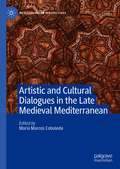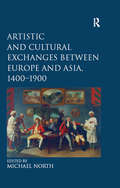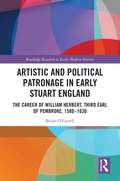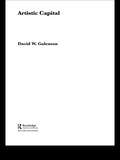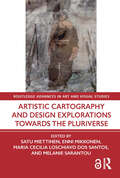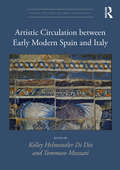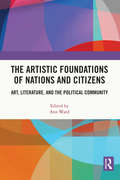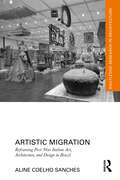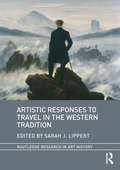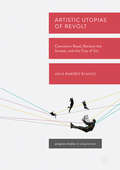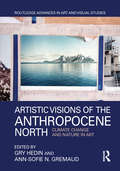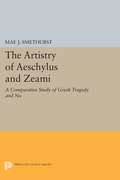- Table View
- List View
Artistic and Cultural Dialogues in the Late Medieval Mediterranean (Mediterranean Perspectives)
by María Marcos CobaledaThis book analyses the artistic and cultural legacy of Western Islamic societies and their interactions with Islamic, Christian and Jewish societies in the framework of the late medieval Mediterranean, from a range of multi-disciplinary perspectives. The book, organised in four parts, addresses the Andalusi legacy from its presence in the East and the West; analyses the relations and transfers between Al-Andalus and the artistic productions of the Christian kingdoms of the Iberian Peninsula; explores other manifestations of the Andalusi legacy in the fields of knowledge, construction, identity and religious studies; and reconsiders ornamental transfers and exchanges in artistic manifestations between East and West across the Mediterranean basin.Chapter 2 is open access under a CC BY 4.0 license.
Artistic and Cultural Exchanges between Europe and Asia, 1400-1900: Rethinking Markets, Workshops and Collections
by Michael NorthThe European expansion to Asia was driven by the desire for spices and Asian luxury products. Its results, however, exceeded the mere exchange of commodities and precious metals. The meeting of Asia and Europe signaled not only the beginnings of a global market but also a change in taste and lifestyle that influences our lives even today. Manifold kinds of cultural transfers evolved within a market framework that was not just confined to intercontinental and intra-Asiatic trade. In Europe and Asia markets for specific cultural products emerged and the transfers of objects affected domestic arts and craft production. Traditionally, relations between Europe and Asia have been studied in a hegemonic perspective, with Europe as the dominant political and economic centre. Even with respect to cultural exchange, the model of diffusion regarded Europe as the centre, and Asia the recipient, whereby Asian objects in Europe became exotica in the Kunst- und Wunderkammern. Conceptions of Europe and Asia as two monolithic regions emerged in this context. However, with the current process of globalization these constructions and the underlying models of cultural exchange have come under scrutiny. For this reason, the book focuses on cultural exchange between different European and Asian civilizations, whereby the reciprocal complexities of cultural transfers are at the centre of observation. By investigating art markets, workshops and collections in Europe and Asia the contributors exemplify the varieties of cultural exchange. The book examines the changing roles of Asian objects in European material culture and collections and puts a special emphasis on the reception of European visual arts in colonial settlements in Asia as well as in different Asian societies.
Artistic and Cultural Exchanges between Europe and Asia, 1400-1900: Rethinking Markets, Workshops and Collections
by Michael NorthThe European expansion to Asia was driven by the desire for spices and Asian luxury products. Its results, however, exceeded the mere exchange of commodities and precious metals. The meeting of Asia and Europe signaled not only the beginnings of a global market but also a change in taste and lifestyle that influences our lives even today. Manifold kinds of cultural transfers evolved within a market framework that was not just confined to intercontinental and intra-Asiatic trade. In Europe and Asia markets for specific cultural products emerged and the transfers of objects affected domestic arts and craft production. Traditionally, relations between Europe and Asia have been studied in a hegemonic perspective, with Europe as the dominant political and economic centre. Even with respect to cultural exchange, the model of diffusion regarded Europe as the centre, and Asia the recipient, whereby Asian objects in Europe became exotica in the Kunst- und Wunderkammern. Conceptions of Europe and Asia as two monolithic regions emerged in this context. However, with the current process of globalization these constructions and the underlying models of cultural exchange have come under scrutiny. For this reason, the book focuses on cultural exchange between different European and Asian civilizations, whereby the reciprocal complexities of cultural transfers are at the centre of observation. By investigating art markets, workshops and collections in Europe and Asia the contributors exemplify the varieties of cultural exchange. The book examines the changing roles of Asian objects in European material culture and collections and puts a special emphasis on the reception of European visual arts in colonial settlements in Asia as well as in different Asian societies.
Artistic and Political Patronage in Early Stuart England: The Career of William Herbert, Third Earl of Pembroke, 1580-1630
by Brian O'FarrellArtistic and Political Patronage in Early Stuart England explores the remarkable life and career of William Herbert, Third Earl of Pembroke. Pembroke was one of the most influential aristocrats during the reigns of Elizabeth I, James I and Charles I. He was a great patron, a prominent politician and electoral manager, an entrepreneur, and a gifted poet. Yet despite his influence and many talents, Pembroke’s life has been little studied by historians. Drawing on archival material, this book throws new light on Pembroke, and demonstrates just how significant he was during his lifetime. This book will appeal to scholars and students of early modern British history, as well as those interested in politics and patronage during the sixteenth and seventeenth centuries.
Artistic and Political Patronage in Early Stuart England: The Career of William Herbert, Third Earl of Pembroke, 1580-1630
by Brian O'FarrellArtistic and Political Patronage in Early Stuart England explores the remarkable life and career of William Herbert, Third Earl of Pembroke. Pembroke was one of the most influential aristocrats during the reigns of Elizabeth I, James I and Charles I. He was a great patron, a prominent politician and electoral manager, an entrepreneur, and a gifted poet. Yet despite his influence and many talents, Pembroke’s life has been little studied by historians. Drawing on archival material, this book throws new light on Pembroke, and demonstrates just how significant he was during his lifetime. This book will appeal to scholars and students of early modern British history, as well as those interested in politics and patronage during the sixteenth and seventeenth centuries.
Artistic Capital
by David GalensonAt what stage of their careers do great artists produce their most important work? In a series of studies that bring new insights and new dimensions to the study of artistic creativity, Galenson’s new book examines the careers of more than one hundred modern painters, poets and novelists to reveal a powerful relationship between age and artistic creativity. Analyzing the careers of major literary and artistic figures, such as Cézanne, van Gogh, Dickens, Hemingway and Plath, Galenson highlights the different methods by which artists have made innovations. Pointing to a new and richer history of the modern arts, this book is of interest, not only to humanists and social scientists, but to anyone interested in the nature of human creativity in general.
Artistic Capital
by David GalensonAt what stage of their careers do great artists produce their most important work? In a series of studies that bring new insights and new dimensions to the study of artistic creativity, Galenson’s new book examines the careers of more than one hundred modern painters, poets and novelists to reveal a powerful relationship between age and artistic creativity. Analyzing the careers of major literary and artistic figures, such as Cézanne, van Gogh, Dickens, Hemingway and Plath, Galenson highlights the different methods by which artists have made innovations. Pointing to a new and richer history of the modern arts, this book is of interest, not only to humanists and social scientists, but to anyone interested in the nature of human creativity in general.
Artistic Cartography and Design Explorations Towards the Pluriverse (Routledge Advances in Art and Visual Studies)
by Satu Miettinen Enni Mikkonen Maria Cecilia Loschiavo dos Santos Melanie SarantouThis edited volume uses an interdisciplinary approach to art and design that not only reframes but also repositions agendas and actions to address fragmented global systems. Contributors explore the pluriverse of art and design through epistemological and methodological considerations. What kinds of sustainable ways are there for knowledge transfer, supporting plural agendas, finding novel ways for unsettling conversations, unlearning and learning and challenging power structures with marginalised groups and contexts through art and design? The main themes of the book are art and design methods, epistemologies and practices that provide critical, interdisciplinary, pluriversal and decolonial considerations. The book challenges the domination of the white logic of art and design and shifts away from the Anglo-European one-world system towards the pluriverse. The book will be of interest to scholars working in art history, visual studies, arts-based research, and design studies.
Artistic Cartography and Design Explorations Towards the Pluriverse (Routledge Advances in Art and Visual Studies)
by Satu Miettinen Enni Mikkonen Maria Cecilia Loschiavo Dos Santos Melanie SarantouThis edited volume uses an interdisciplinary approach to art and design that not only reframes but also repositions agendas and actions to address fragmented global systems. Contributors explore the pluriverse of art and design through epistemological and methodological considerations. What kinds of sustainable ways are there for knowledge transfer, supporting plural agendas, finding novel ways for unsettling conversations, unlearning and learning and challenging power structures with marginalised groups and contexts through art and design? The main themes of the book are art and design methods, epistemologies and practices that provide critical, interdisciplinary, pluriversal and decolonial considerations. The book challenges the domination of the white logic of art and design and shifts away from the Anglo-European one-world system towards the pluriverse. The book will be of interest to scholars working in art history, visual studies, arts-based research, and design studies.
Artistic Circulation between Early Modern Spain and Italy (Visual Culture in Early Modernity)
by Kelley Helmstutler Di Dio Tommaso MozzatiThis collection of essays by major scholars in the field explores how the rich intersections between Italy and Spain during the early modern period resulted in a confluence of cultural ideals. Various means of exchange and convergence are explored through two main catalysts: humans—their trips or resettlements—and objects—such as books, paintings, sculptures, and prints. The visual and textual evidence of the transmission of ideas, iconographies and styles are examined, such as triumphal ephemera, treatises on painting, the social status of the artist, collections and their display, church decoration, and funerary monuments, providing a more nuanced understanding of the exchanges of styles, forms and ideals across southern Europe.
Artistic Circulation between Early Modern Spain and Italy (Visual Culture in Early Modernity)
by Kelley Helmstutler Di Dio Tommaso MozzatiThis collection of essays by major scholars in the field explores how the rich intersections between Italy and Spain during the early modern period resulted in a confluence of cultural ideals. Various means of exchange and convergence are explored through two main catalysts: humans—their trips or resettlements—and objects—such as books, paintings, sculptures, and prints. The visual and textual evidence of the transmission of ideas, iconographies and styles are examined, such as triumphal ephemera, treatises on painting, the social status of the artist, collections and their display, church decoration, and funerary monuments, providing a more nuanced understanding of the exchanges of styles, forms and ideals across southern Europe.
The Artistic Foundations of Nations and Citizens: Art, Literature, and the Political Community
by Ann WardThis book examines politics through the lens of art and literature. Through discussion on great works of visual art, literature, and cultural representations of political thought in the medieval, early modern, and American eras, it explores the relevance of the nation-state to human freedom and flourishing, as well as the concept of citizenship and statesmanship that it implies, in contrast to that of the ‘global community’. The essays in this volume focus on shifting notions of various core political concepts like citizenship, republicanism, and nationalism from antiquity to the present-day to provide a systematic understanding of their evolving histories through Western Art and literature. It highlights works such as the Bayeux Tapestry, Shakespeare’s Henry V, Henry VI, and A Midsummer Night’s Dream, Twain’s Joan of Arc and Hermann’s Nichts als Gespenster, among several other canonical works of political interest. Further, it questions if we should now look beyond the nation-state to some form of tans-national, global community to pursue the human freedom desired by progressives, or look at smaller forms of community resembling the polis to pursue the friendship and nobility valued by the ancients. The volume will be invaluable to students and teachers of political science, especially political theory and philosophy, visual arts, and world literature.
The Artistic Foundations of Nations and Citizens: Art, Literature, and the Political Community
by Ann WardThis book examines politics through the lens of art and literature. Through discussion on great works of visual art, literature, and cultural representations of political thought in the medieval, early modern, and American eras, it explores the relevance of the nation-state to human freedom and flourishing, as well as the concept of citizenship and statesmanship that it implies, in contrast to that of the ‘global community’. The essays in this volume focus on shifting notions of various core political concepts like citizenship, republicanism, and nationalism from antiquity to the present-day to provide a systematic understanding of their evolving histories through Western Art and literature. It highlights works such as the Bayeux Tapestry, Shakespeare’s Henry V, Henry VI, and A Midsummer Night’s Dream, Twain’s Joan of Arc and Hermann’s Nichts als Gespenster, among several other canonical works of political interest. Further, it questions if we should now look beyond the nation-state to some form of tans-national, global community to pursue the human freedom desired by progressives, or look at smaller forms of community resembling the polis to pursue the friendship and nobility valued by the ancients. The volume will be invaluable to students and teachers of political science, especially political theory and philosophy, visual arts, and world literature.
Artistic gymnastics (Large Print)
by RnibThis page shows images of gymnasts taking part in five events: the high bar, the pommel horse, the rings, the uneven bars, and the beam. Each image has a dashed line image border. There is a locator dot shown, which will be at the top left of the page when the image is the right way up. The high bar (top left) This athlete is shown balanced on the high bar on one hand. He is seen upside down from the front. His feet are at the top centre of the image, and down the page from this are his legs and torso with one bent arm to the right. Further down is his head and his other straight arm with his hand holding onto the bar running horizontally across the bottom of the image. He is wearing tracksuit trousers, a singlet, and gloves to protect his hands. The pommel horse (top centre) This gymnast is seen from the back, balancing upside down on a pommel horse. His legs are at the top of the image stretching out to the right and left horizontally. Down the page is his torso and head. His arms, to either side of his head, continue down to hands holding on to the handles of the pommel horse. He is wearing tracksuit trousers and a singlet. Further down the page is the pommel horse with legs extending to the floor at the bottom of the image. The rings (top right) This gymnast is performing the very demanding iron cross exercise on the rings. He is seen from the front with his head at the top of the image. At the top of the image, to the left and right, are the ring's ropes; they continue upwards out of the image border. Between these is the gymnast's head, and stretching out horizontally left and right his arms can be found with his gloved hands gripping the two rings. His torso is down the page from his head and further down you can find his legs hanging down to the bottom of the image. He is wearing tracksuit trousers and a singlet. The uneven (asymmetric) bars (bottom left) In this picture the athlete, seen from the front, is in mid-air swinging from one bar to the other. The gymnast's arms reach out to the left and right at the top of the image with her hands held up ready to catch the top bar. Between her arms, her head can be found with her hair styled into a bun. Further down the page is her torso, and down again her legs stretch out in a 'splits' position to the left and right. She is wearing a leotard. The upper bar extends across the page in front of her legs and torso, and the lower one is at the bottom of the image and closer than the top bar. The beam (bottom right) This gymnast is performing an exercise on the ten-centimetre-wide balance beam. She is seen from the side with her legs stretching left and right across the top of the image. Her torso is in the middle of the page. Down the page to the left, one of her arms is visible with her hand holding the beam and to the right her head facing to the right. She is wearing a leotard. The beam extends across the bottom of the image.
Artistic gymnastics (UEB Contracted)
by RnibThis page shows images of gymnasts taking part in five events: the high bar, the pommel horse, the rings, the uneven bars, and the beam. Each image has a dashed line image border. There is a locator dot shown, which will be at the top left of the page when the image is the right way up. The high bar (top left) This athlete is shown balanced on the high bar on one hand. He is seen upside down from the front. His feet are at the top centre of the image, and down the page from this are his legs and torso with one bent arm to the right. Further down is his head and his other straight arm with his hand holding onto the bar running horizontally across the bottom of the image. He is wearing tracksuit trousers, a singlet, and gloves to protect his hands. The pommel horse (top centre) This gymnast is seen from the back, balancing upside down on a pommel horse. His legs are at the top of the image stretching out to the right and left horizontally. Down the page is his torso and head. His arms, to either side of his head, continue down to hands holding on to the handles of the pommel horse. He is wearing tracksuit trousers and a singlet. Further down the page is the pommel horse with legs extending to the floor at the bottom of the image. The rings (top right) This gymnast is performing the very demanding iron cross exercise on the rings. He is seen from the front with his head at the top of the image. At the top of the image, to the left and right, are the ring's ropes; they continue upwards out of the image border. Between these is the gymnast's head, and stretching out horizontally left and right his arms can be found with his gloved hands gripping the two rings. His torso is down the page from his head and further down you can find his legs hanging down to the bottom of the image. He is wearing tracksuit trousers and a singlet. The uneven (asymmetric) bars (bottom left) In this picture the athlete, seen from the front, is in mid-air swinging from one bar to the other. The gymnast's arms reach out to the left and right at the top of the image with her hands held up ready to catch the top bar. Between her arms, her head can be found with her hair styled into a bun. Further down the page is her torso, and down again her legs stretch out in a 'splits' position to the left and right. She is wearing a leotard. The upper bar extends across the page in front of her legs and torso, and the lower one is at the bottom of the image and closer than the top bar. The beam (bottom right) This gymnast is performing an exercise on the ten-centimetre-wide balance beam. She is seen from the side with her legs stretching left and right across the top of the image. Her torso is in the middle of the page. Down the page to the left, one of her arms is visible with her hand holding the beam and to the right her head facing to the right. She is wearing a leotard. The beam extends across the bottom of the image.
Artistic gymnastics (UEB Uncontracted)
by RnibThis page shows images of gymnasts taking part in five events: the high bar, the pommel horse, the rings, the uneven bars, and the beam. Each image has a dashed line image border. There is a locator dot shown, which will be at the top left of the page when the image is the right way up. The high bar (top left) This athlete is shown balanced on the high bar on one hand. He is seen upside down from the front. His feet are at the top centre of the image, and down the page from this are his legs and torso with one bent arm to the right. Further down is his head and his other straight arm with his hand holding onto the bar running horizontally across the bottom of the image. He is wearing tracksuit trousers, a singlet, and gloves to protect his hands. The pommel horse (top centre) This gymnast is seen from the back, balancing upside down on a pommel horse. His legs are at the top of the image stretching out to the right and left horizontally. Down the page is his torso and head. His arms, to either side of his head, continue down to hands holding on to the handles of the pommel horse. He is wearing tracksuit trousers and a singlet. Further down the page is the pommel horse with legs extending to the floor at the bottom of the image. The rings (top right) This gymnast is performing the very demanding iron cross exercise on the rings. He is seen from the front with his head at the top of the image. At the top of the image, to the left and right, are the ring's ropes; they continue upwards out of the image border. Between these is the gymnast's head, and stretching out horizontally left and right his arms can be found with his gloved hands gripping the two rings. His torso is down the page from his head and further down you can find his legs hanging down to the bottom of the image. He is wearing tracksuit trousers and a singlet. The uneven (asymmetric) bars (bottom left) In this picture the athlete, seen from the front, is in mid-air swinging from one bar to the other. The gymnast's arms reach out to the left and right at the top of the image with her hands held up ready to catch the top bar. Between her arms, her head can be found with her hair styled into a bun. Further down the page is her torso, and down again her legs stretch out in a 'splits' position to the left and right. She is wearing a leotard. The upper bar extends across the page in front of her legs and torso, and the lower one is at the bottom of the image and closer than the top bar. The beam (bottom right) This gymnast is performing an exercise on the ten-centimetre-wide balance beam. She is seen from the side with her legs stretching left and right across the top of the image. Her torso is in the middle of the page. Down the page to the left, one of her arms is visible with her hand holding the beam and to the right her head facing to the right. She is wearing a leotard. The beam extends across the bottom of the image.
Artistic Migration: Reframing Post-War Italian Art, Architecture, and Design in Brazil (Routledge Research in Architecture)
by Aline Coelho SanchesArtistic Migration: Reframing Post-War Italian Art, Architecture, and Design in Brazil investigates a selection of works by Italian artists and architects, and an art critic and dealer, who immigrated to Brazil after World War II, and were involved in the first activities and opportunities created by the São Paulo Museum of Art (MASP).Although foreigners, these experts, namely Bramante Buffoni, Roberto Sambonet, Lina Bo Bardi, Giancarlo Palanti, and Pietro Maria Bardi, were engaged in the construction of paths for Brazilian art, architecture, and design, in production marked by the intertwining of artistic disciplines. By examining the works produced between 1946 and 1991, and focusing on the relationship between art and architecture, with previously unexplored cases, the text investigates how these actors engaged in the dilemmas of Brazilian culture and became part of its invention. The intention is to understand the nature and meaning of this recognizable experience, the continuities of and ruptures from modern architectural, art and design ideals, pre-war experience, and immigration, illuminating a complex framework of relationships with local ideas.The approach and the extensive archival research in Italy and Brazil adopted for the book sheds new light on critically rethinking and reframing Italian and Brazilian cultural events, and will be of interest to architects, researchers, teachers, and students interested in the history of architecture, museums, design, and art.
Artistic Migration: Reframing Post-War Italian Art, Architecture, and Design in Brazil (Routledge Research in Architecture)
by Aline Coelho SanchesArtistic Migration: Reframing Post-War Italian Art, Architecture, and Design in Brazil investigates a selection of works by Italian artists and architects, and an art critic and dealer, who immigrated to Brazil after World War II, and were involved in the first activities and opportunities created by the São Paulo Museum of Art (MASP).Although foreigners, these experts, namely Bramante Buffoni, Roberto Sambonet, Lina Bo Bardi, Giancarlo Palanti, and Pietro Maria Bardi, were engaged in the construction of paths for Brazilian art, architecture, and design, in production marked by the intertwining of artistic disciplines. By examining the works produced between 1946 and 1991, and focusing on the relationship between art and architecture, with previously unexplored cases, the text investigates how these actors engaged in the dilemmas of Brazilian culture and became part of its invention. The intention is to understand the nature and meaning of this recognizable experience, the continuities of and ruptures from modern architectural, art and design ideals, pre-war experience, and immigration, illuminating a complex framework of relationships with local ideas.The approach and the extensive archival research in Italy and Brazil adopted for the book sheds new light on critically rethinking and reframing Italian and Brazilian cultural events, and will be of interest to architects, researchers, teachers, and students interested in the history of architecture, museums, design, and art.
Artistic Responses to Travel in the Western Tradition (Routledge Research in Art History)
by Sarah J. LippertIn an era when ease of travel is greater than ever, it is also easy to overlook the degree to which voyages of the body – and mind – have generated an outpouring of artistry and creativity throughout the ages. Exploration of new lands and sensations is a fundamental human experience. This volume in turn provides a stimulating and adventurous exploration of the theme of travel from an art-historical perspective. Topical regions are covered ranging from the Grand Tour and colonialism to the travels of Hadrian in ancient times and Georgia O’Keeffe’s journey to the Andes; from Vasari’s Neoplatonic voyages to photographing nineteenth-century Japan. The scholars assembled consider both imaginary travel, as well as factual or embellished documentation of voyages. The essays are far-reaching spatially and temporally, but all relate to how art has documented the theme of travel in varying media across time and as illustrated and described by writers, artists, and illustrators. The scope of this volume is far-reaching both chronologically and conceptually, thereby appropriately documenting the universality of the theme to human experience.
Artistic Responses to Travel in the Western Tradition (Routledge Research in Art History)
by Sarah J. LippertIn an era when ease of travel is greater than ever, it is also easy to overlook the degree to which voyages of the body – and mind – have generated an outpouring of artistry and creativity throughout the ages. Exploration of new lands and sensations is a fundamental human experience. This volume in turn provides a stimulating and adventurous exploration of the theme of travel from an art-historical perspective. Topical regions are covered ranging from the Grand Tour and colonialism to the travels of Hadrian in ancient times and Georgia O’Keeffe’s journey to the Andes; from Vasari’s Neoplatonic voyages to photographing nineteenth-century Japan. The scholars assembled consider both imaginary travel, as well as factual or embellished documentation of voyages. The essays are far-reaching spatially and temporally, but all relate to how art has documented the theme of travel in varying media across time and as illustrated and described by writers, artists, and illustrators. The scope of this volume is far-reaching both chronologically and conceptually, thereby appropriately documenting the universality of the theme to human experience.
Artistic Utopias of Revolt: Claremont Road, Reclaim the Streets, and the City of Sol (Palgrave Studies in Utopianism)
by Julia Ramírez BlancoThis book analyses the aesthetic and utopian dimensions of various activist social movements in Western Europe since 1989. Through a series of case studies, it demonstrates how dreams of a better society have manifested themselves in contexts of political confrontation, and how artistic forms have provided a language to express the collective desire for social change.The study begins with the 1993 occupation of Claremont Road in east London, an attempt to prevent the demolition of homes to make room for a new motorway. In a squatted row of houses, all available space was transformed and filled with elements that were both aesthetic and defensive – so when the authorities arrived to evict the protestors, sculptures were turned into barricades. At the end of the decade, this kind of performative celebration merged with the practices of the antiglobalisation movement, where activists staged spectacular parallel events alongside the global elite’s international meetings. As this book shows, social movements try to erase the distance that separates reality and political desire, turning ordinary people into creators of utopias. Squatted houses, carnivalesque street parties, counter-summits, and camps in central squares, all create a physical place of these utopian visions
Artistic Utopias of Revolt: Claremont Road, Reclaim the Streets, and the City of Sol (Palgrave Studies in Utopianism)
by Julia Ramírez BlancoThis book analyses the aesthetic and utopian dimensions of various activist social movements in Western Europe since 1989. Through a series of case studies, it demonstrates how dreams of a better society have manifested themselves in contexts of political confrontation, and how artistic forms have provided a language to express the collective desire for social change.The study begins with the 1993 occupation of Claremont Road in east London, an attempt to prevent the demolition of homes to make room for a new motorway. In a squatted row of houses, all available space was transformed and filled with elements that were both aesthetic and defensive – so when the authorities arrived to evict the protestors, sculptures were turned into barricades. At the end of the decade, this kind of performative celebration merged with the practices of the antiglobalisation movement, where activists staged spectacular parallel events alongside the global elite’s international meetings. As this book shows, social movements try to erase the distance that separates reality and political desire, turning ordinary people into creators of utopias. Squatted houses, carnivalesque street parties, counter-summits, and camps in central squares, all create a physical place of these utopian visions
Artistic Visions of the Anthropocene North: Climate Change and Nature in Art (Routledge Advances in Art and Visual Studies)
by Gry Hedin Ann-Sofie N. GremaudIn the era of the Anthropocene, artists and scientists are facing a new paradigm in their attempts to represent nature. Seven chapters, which focus on art from 1780 to the present that engages with Nordic landscapes, argue that a number of artists in this period work in the intersection between art, science, and media technologies to examine the human impact on these landscapes and question the blurred boundaries between nature and the human. Canadian artists such as Lawren Harris and Geronimo Inutiq are considered alongside artists from Scandinavia and Iceland such as J.C. Dahl, Eija-Liisa Ahtila, Toril Johannessen, and Björk.
Artistic Visions of the Anthropocene North: Climate Change and Nature in Art (Routledge Advances in Art and Visual Studies)
by Gry Hedin Ann-Sofie N. GremaudIn the era of the Anthropocene, artists and scientists are facing a new paradigm in their attempts to represent nature. Seven chapters, which focus on art from 1780 to the present that engages with Nordic landscapes, argue that a number of artists in this period work in the intersection between art, science, and media technologies to examine the human impact on these landscapes and question the blurred boundaries between nature and the human. Canadian artists such as Lawren Harris and Geronimo Inutiq are considered alongside artists from Scandinavia and Iceland such as J.C. Dahl, Eija-Liisa Ahtila, Toril Johannessen, and Björk.
The Artistry of Aeschylus and Zeami: A Comparative Study of Greek Tragedy and No
by Mae J. SmethurstBy means of a cross-cultural analysis of selected examples of early Japanese and early Greek drama, Mae Smethurst enhances our appreciation of each form. While using the methods of a classicist to increase our understanding of no as literary texts, she also demonstrates that the fifteenth-century treatises of Zeami--an important playwright, actor, critic, and teacher of no--offer fresh insight into Aeschylus' use of actors, language, and various elements of stage presentation.Relatively little documentation apart from the texts of the plays is available for the Greek theater of the fifth century B.C., but Smethurst uses documentation on no, and evidence from no performances today, to suggest how presentations of the Persians could have been so successful despite the play's lack of dramatic confrontation. Aeschylean theater resembles that of Zeami in creating its powerful emotional and aesthetic effect through a coherent organization of structural elements. Both playwrights used such methods as the gradual intensification of rhythmic and musical effects, an increase in the number and complexity of the actors' movements, and a progressive focusing of attention on the main actors and on costumes, masks, and props during the course of the play.Originally published in 1989.The Princeton Legacy Library uses the latest print-on-demand technology to again make available previously out-of-print books from the distinguished backlist of Princeton University Press. These editions preserve the original texts of these important books while presenting them in durable paperback and hardcover editions. The goal of the Princeton Legacy Library is to vastly increase access to the rich scholarly heritage found in the thousands of books published by Princeton University Press since its founding in 1905.
